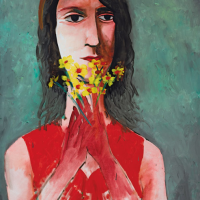32. CHARLES BLACKMAN

Charles Blackmans Red Dress and Yellow Jonquils, c.1958, combines strong graphic elements with wonderful, bright and life-affirming colours. It was produced following the famous Alice in Wonderland series of paintings and continued the theme of depicting single figures, usually girls or women, holding flowers. Charles wife Barbara had lost most of her sight and he was exploring how the development of other senses could compensate for this loss as well as the important role played by the emotional import of colour.1
The Faces and flowers series, as they were called, were painted during the late 1950s. Charles and Barbara Blackman returned regularly to their native Brisbane. With each visit, Charles renewed his appreciation of the flowers at Barbaras mothers garden, where the two were living and working, and in the nearby flower farms at Tamborine. A selection of the new works was shown at Blackmans second solo exhibition at Johnstone Galleries, in late 1958. The press notices acknowledged Blackmans rising star, including the acceptance of one of his paintings by the Musee dArt Modern, Paris. At the age of thirty, it was stated, Charles Blackman has quietly established for himself a position at the forefront of Australian Art.2
The front cover of the Faces and flowers catalogue illustrated a painting that depicted a woman, possibly Barbara Blackman, luxuriating over the perfume emanating from a bunch of newly picked flowers. The womans closed eyes, strong facial outlines and deeply modelled face give a strong sense of her resolute personality and exude little in the way of sentimentality or regret. This is true also of other works from the series including Girl with a Nosegay (1959), from the Tarrawarra Collection, and the equally masterful Reflections, 1958 catalogue number 22 in the Johnstone exhibition, and a work recently brought to light by Menzies in 2018.3
Red Dress and Yellow Jonquils follows in the same vein of these paintings but with one notable exception the eyes of the central figure are shown wide-open and stare outwardly into space. For French modernist Odilon Redon (1840-1916) one of Blackmans favourite artists closed eyes signified dream states and the interior world of the imagination. Eyes open, on the other hand, directed the viewers towards a stronger reliance on other physical senses, such as touch and smell.
In Red Dress and Yellow Jonquils, the woman draws the flowers towards her nose. She is fully immersed in the sensation of smelling and holding the flowers. This is reinforced by the way the woman is integrated into the surroundings using colour the dominant chord of red spreads like wildfire from the flowers to the hands, the arms, lips and dress. Blackman may also have had in mind the more conventional symbolism of jonquils and links with narcissism and a desire for the return of unrequited love.
Barbara and Auguste, a wonderful portrait of mother and child painted in 1957, provides a clear resemblance to Red Dress and Yellow Jonquils. Barbaras strong facial features, darkened eyes and tousled black hair appears to be the model for the latter painting as well. A dream-state or reverie is achieved by the spread of colour and the woman appears intoxicated by the newborn child, in a pose reminiscent of someone inhaling flowers blissfully.
Red Dress and Yellow Jonquils is an important work from a productive period of Charles Blackmans career. It joins a growing rank of intriguing and highly accomplished paintings that have recently come to light and brings new perspectives to the maturation and development of his art.
Footnotes
1. Gertrude Langer, Courier Mail, Brisbane, 18 November 1958
2. Faces and flowers, The Johnstone Gallery, Brisbane, exhibition catalogue, 17 Nov 5 Dec 1958
3. Reflections 1959, oil on board, 125.5 x 90.0 cm, Menzies Sydney, 9 August 2018, lot 27
Rodney James BA (Hons), MA